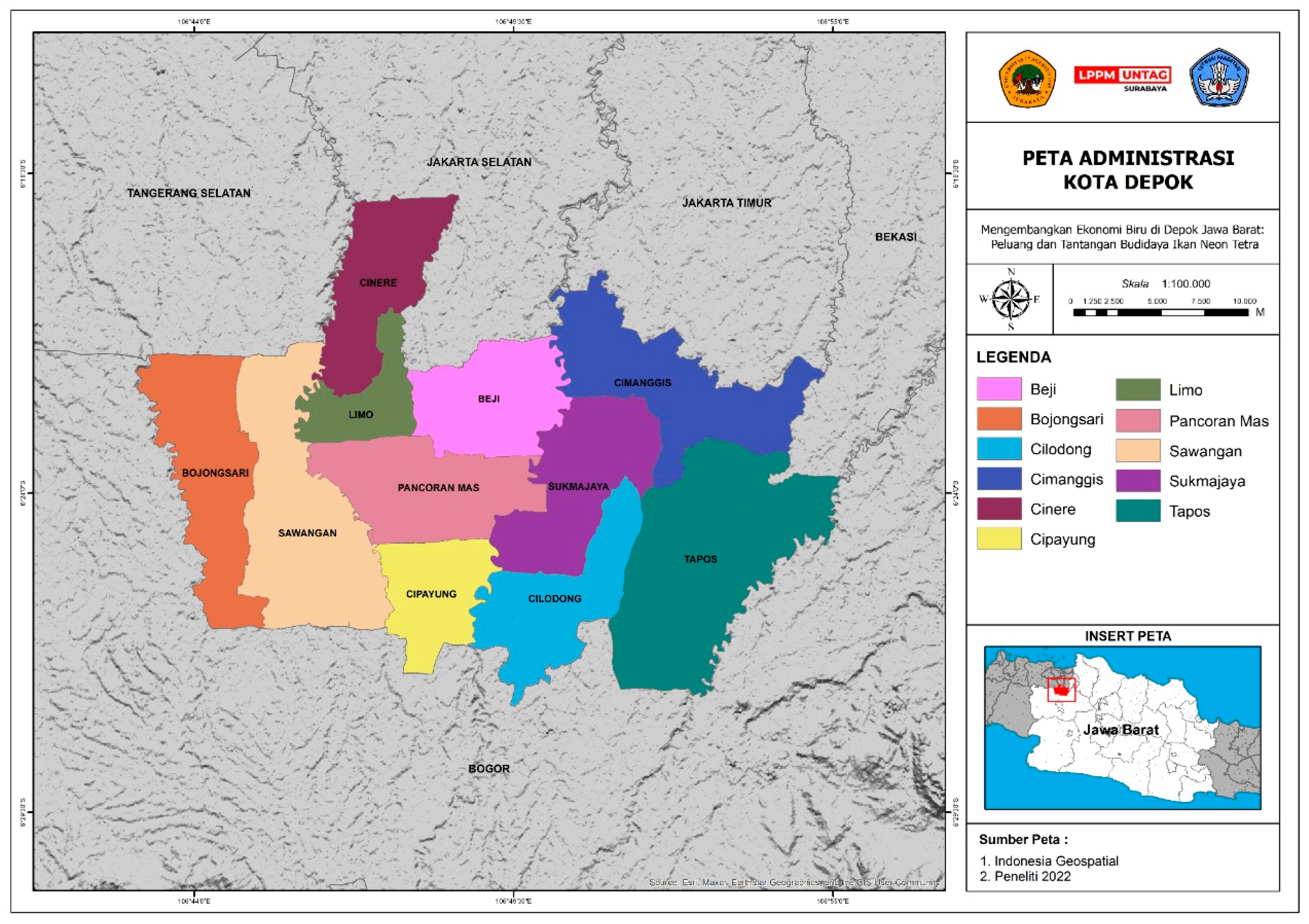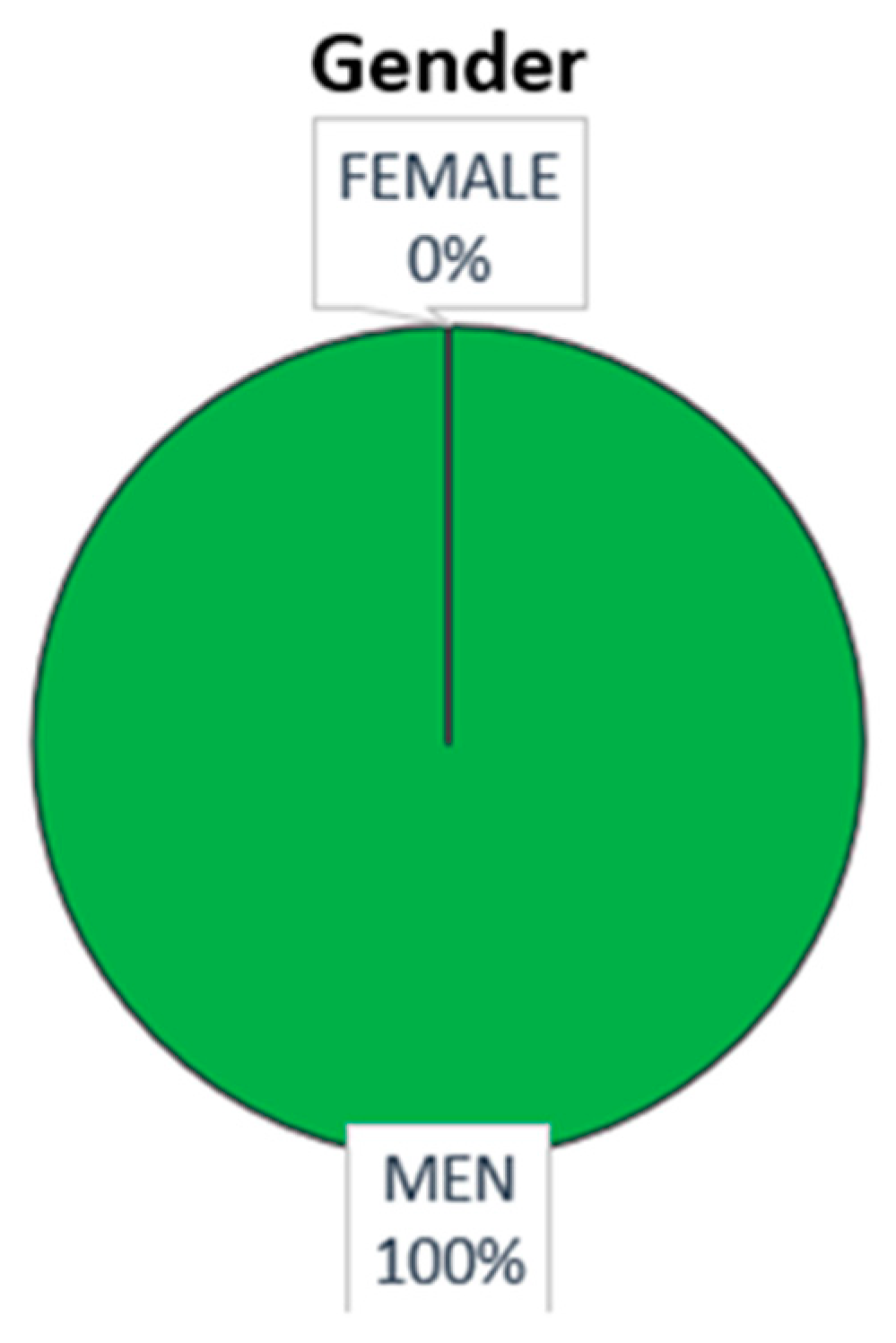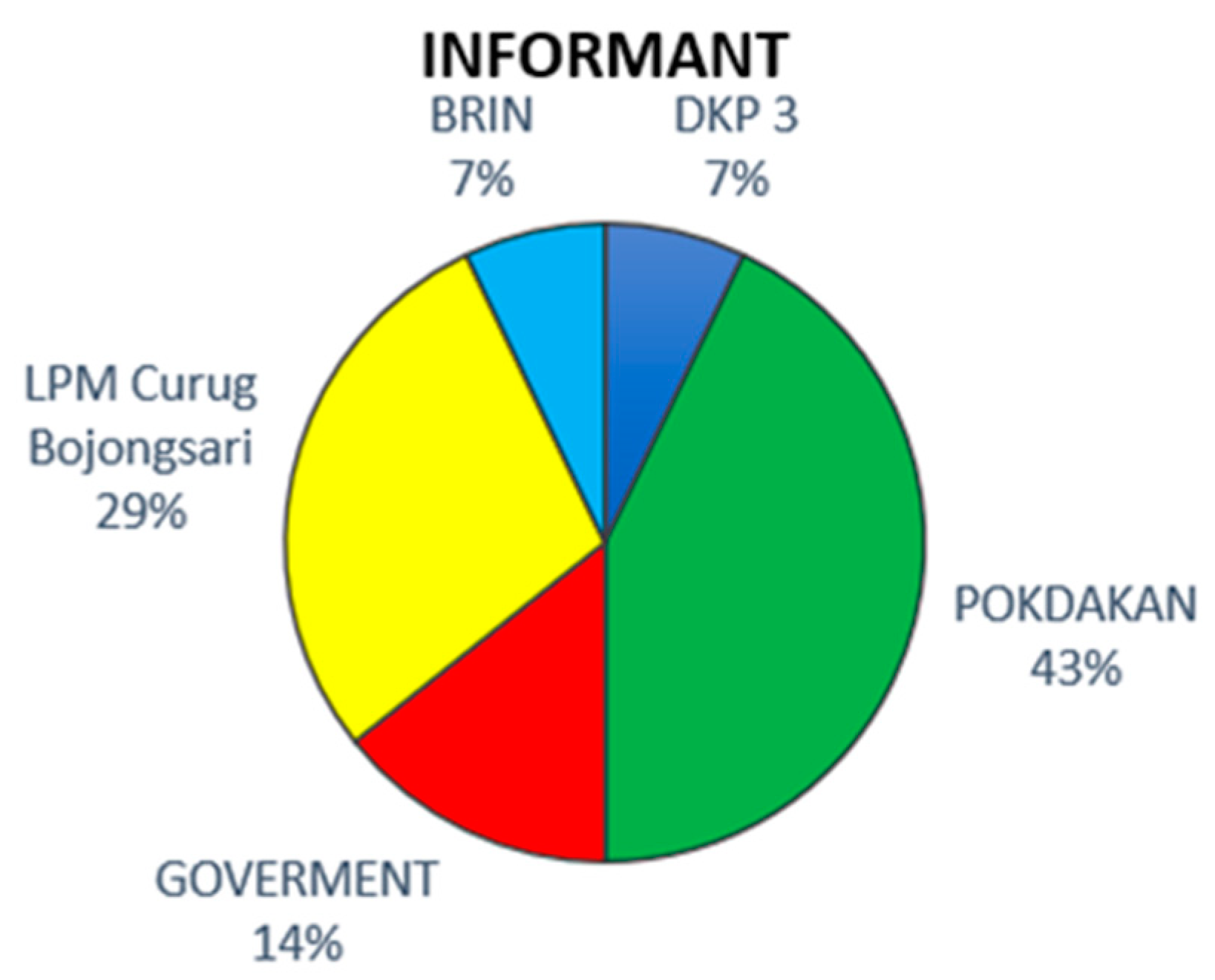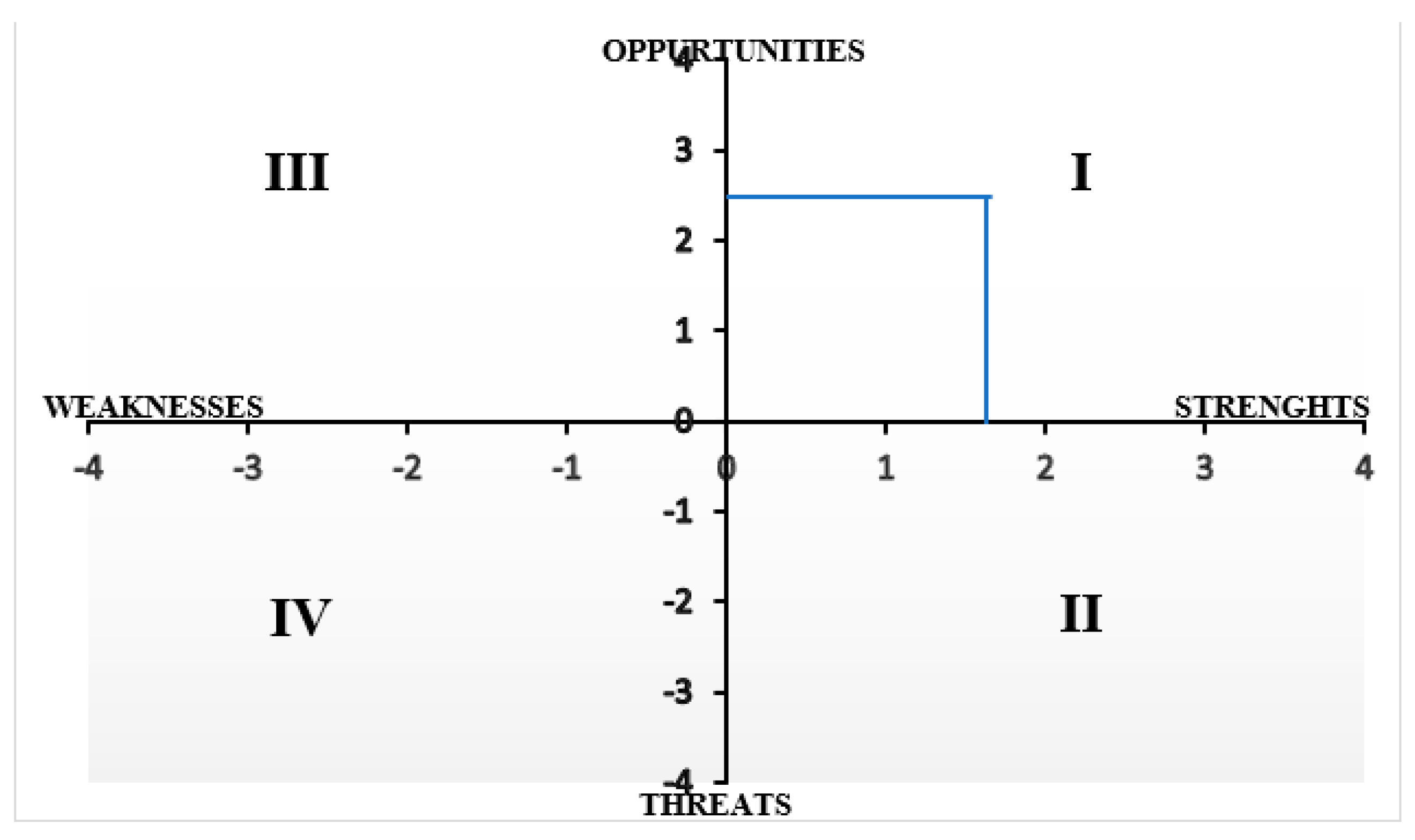Developing a Blue Economy in Depok West Java, Indonesia: Opportunities and Challenges of Neon Tetra Fish Cultivation
Abstract
:1. Introduction
2. Materials and Methods
3. Research Results
3.1. How to Develop a Blue Economy
3.2. SWOT Analysis Techniques (Strengths, Weaknesses, Opportunities, Threats)
4. Discussion
4.1. An Alternative Approach to Implementing the Blue Economy Concept Is the SO (Strength Opportunity) Strategy. POKDAKAN Is in Charge of Maintaining the Quality Standards of Neon Tetra Fish Production with Good Fish Cultivation (CBIB) in Order to Expand the Target Market
4.2. Another Way to Implement the Blue Economy Idea Is to Implement a Business Finance Strategy with Limited Losses: WO (Weak Opportunity) Strategy
4.3. By Providing Easy Services to Clients Such as Online Reservation and Delivery of Ornamental Fish to Their Location, the ST (Strength Threat) Strategy Increases Brand Perception among Customers as an Alternative to the Implementation of the Blue Economy Concept
4.4. An Alternative Approach to Implementing the Blue Economy Concept Is the WT (Weakness Threat) Strategy, Which Includes Every POKDAKAN Member, including the Chairperson, as a Training Participant
5. Conclusions
- In order to give the greatest service to consumers, both short-and long-term plans must be made for business continuity, including the use of new technology and constant maintenance of fish quality.
- To be able to remain competitive with competitors, it is necessary to increase the skills possessed, especially human resources, in this case cultivators who are always directly concerned with the results with regard to their fish.
- This is what POKDAKAN does with long-term efforts such as continuing to create jobs for the surrounding community.
- Strong motivation is needed from POKDAKAN by participating in continuous training.
- Good HR management will be very beneficial for POKDAKAN because it will save costs, improve performance, accelerate the achievement of goals, and at the same time will create a good relationship between Members and the Chairperson of POKDAKAN.
Supplementary Materials
Author Contributions
Funding
Institutional Review Board Statement
Informed Consent Statement
Data Availability Statement
Acknowledgments
Conflicts of Interest
References
- Bappenas. Kajian Strategi Pengelolaan Perikanan Berkelanjutan. Kementerian PPN/Bapenas Direktorat Kelautan Dan Perikanan; Ministry of National Development Planning of the Republic of Indonesia: Jakarta, Indonesia, 2014; p. 120.
- Prayuda, S.; dan Sary, D.V. Strategi Indonesia dalam Implementasi Konsep Bl ue Economy terhadap Pemberdayaan Masyarakat Pesisir Di Era Masyarakat Ekonomi ASEAN. Indones. J. Int. Relat. 2019, 3, 46–64. [Google Scholar]
- World Bank, The Potential of the Blue Economy; The World Bank: Washington, DC, USA, 2017.
- Chandra, Y.A.; Rustam, I.; Safitri, P. Implementasi Kebijakan Berbasis Blue Economy dalam Kerangka Kerjasama Pemerintah Indonesia dengan FAO: Studi Mengenai Unit Pengolahan Ikan di Kabupaten Lombok Utara. Indones. J. Glob. Discourse 2021, 3, 1–19. [Google Scholar] [CrossRef]
- Rani, F.; dan Cahyasari, W. Motivasi Indonesia dalam Menerapkan Model Kebijakan Blue Economy Masa Pemerintah Joko Widodo. J. Transnasional 2015, 7, 1914–1928. [Google Scholar]
- Radiarta, I.N.; Erlania, E.; Haryadi, J. Analisis Pengembangan Perikanan Budidaya Berbasis Ekonomi Biru Dengan Pendekatan Analytic Hierarchy Process (Ahp). J. Sos. Ekon. Kelaut. Dan Perikan. 2016, 10, 47. [Google Scholar] [CrossRef]
- Hamidy, N.; Alipur, H.; Nasab, S.N.H.; Yazdani, A.; Shojaei, S. Spatial evaluation of appropriate areas to collect runoff using Analytic Hierarchy Process (AHP) and Geographical Information System (GIS) (case study: The catchment ‘Kasef’ in Bardaskan. Model. Earth Syst. Environ. 2016, 2, 1–11. [Google Scholar] [CrossRef] [Green Version]
- Setiyowati, H.; Thalib, S.; Setiawati, R.; Nurjannah, N.; Akbariani, N.V. An Aquaculture Distrupted By Digital Technology. AUSTENIT 2022, 14, 12–16. [Google Scholar] [CrossRef]
- Suman, A.; Irianto, H.E.; Satria, F.; Amri, K. Potensi dan tingkat pemanfaatan sumber daya ikan di wilayah pengelolaan perikanan Negara Republik Indonesia (WPP NRI) Tahun 2015 serta Opsi Pengelolaannya. J. Kebijak. Perikan. Indones. 2017, 8, 97–100. [Google Scholar]
- Nurhayati, S. “Blue and Economy Policy”and Their Impact to Indonesian Community Welfare. J. Ekon. Dan Bisnis 2013, 12, 37–42. [Google Scholar]
- Rohmy, S.; Murniasih, S. Kapasitas Reproduksi ikan neon tetra (Paracheirodon innesi) (Studi Kasus Kelompok Pembudidaya Ikan Curug Jaya, Depok). Pros. Forum Inov. Teknol. Akuakultur 2013, 2013, 325–329. [Google Scholar]
- Mukhiar, S.N.S.; Rahman, N.A.A.; Zolkepli, I.A.A. Conceptualising Identity Negotiation through Symbolic Con-Sumption in Malaysian Muslim Converts. 2022. Available online: https://www.researchgate.net/publication/360611707_Science_Education_and_Innovations_in_the_context_of_modern_problems_-SEI_2790-0169_IMCRA_-International_Meetings_and_Conferences_Research_Association_299_CONCEPTUALISING_IDENTITY_NEGOTIATION_THROUGH_S (accessed on 8 June 2022).
- Ayilu, R.K.; Fabinyi, M.; Barclay, K. Small-scale fisheries in the blue economy: Review of scholarly papers and multilateral documents. Ocean. Coast. Manag. 2022, 216, 105982. [Google Scholar] [CrossRef]
- Widyaningrum, L.; Suhartini, A.M. Analysis of Share in The Fishery Sector Before and After Implementation of The Blue Economy Policy and The Other Variables Affect It in Indonesia, 1990–2018); The World Bank: Washington, DC, USA, 2019; pp. 1316–1325. [Google Scholar]
- Godfrey, S. Defining the blue economy. Marit. Aff. J. Natl. Marit. Found. India 2016, 12, 58–64. [Google Scholar] [CrossRef]
- Asis, A.; Lewerissa, Y.A. Destructive Fishing Criminal Policy in Fisheries Management Area (WPP). Dialogos 2021, 25, 125–132. [Google Scholar]
- Chen, S.; De Bruyne, C. Blue Economy: Community Case Studies Addressing the Poverty—Environment Nexus in Ocean and Coastal Management. Sustainability 2020, 12, 4654. [Google Scholar] [CrossRef]
- Cvitanovic, C.; Mackay, M.; Kelly, R.; Wilson, S.K.; Waples, K.; Nash, K.L.; van Putten, E.I.; Field, S.; Botterill-James, T.; Austin, B.J.; et al. Thirty critical research needs for managing an ecologically and culturally unique remote marine environment. Ocean. Coast. Manag. 2021, 212, 105771. [Google Scholar] [CrossRef]
- Schutter, M.S. Ecosystem Services and the Blue Economy: Navigating Power and Values. In PQDT—Global; University of Exeter: Exeter, UK, 2020; p. 224. Available online: https://uoelibrary.idm.oclc.org/login?url= (accessed on 17 May 2022).
- Sitorus, H.W. Analisis Konsep Blue Economy pada Sektor Kelautan di Indonesia Berdasarkan Undang-Undang Nomor 32 Tahun 2014 Tentang Kelautan. JOM Fak. Huk. 2018, 5, 1–15. [Google Scholar]
- Smith-Godfrey, S. Performance indicators for the blue economy. Aust. J. Marit. Ocean. Aff. 2021, 14, 149–170. [Google Scholar] [CrossRef]
- Wiber, M.G.; Mather, C.; Knott, C.; López Gómez, M.A. Regulating the Blue Economy? Challenges to an effective Canadian aquaculture act. Mar. Policy 2021, 131, 104700. [Google Scholar] [CrossRef]
- Xie, Z. Clusters, and the blue economy in The People’s Republic of China; Asian Development Bank Institute: Tokyo, Japan, 2021; Volume 1296. [Google Scholar]
- Setiyowati, H.; Wulandjani, H.; Shafenti, S. Marketing Management; Rafikatama: Jakarta, Indonesia, 2018. [Google Scholar]
- Armstrong, M. Armstrong’s Handbook of Strategic Human Resource Management; Kogan Page: London, UK, 2008. [Google Scholar]
- David, F.R. Strategic Management, 12th ed.; Salemba Empat: Jakarta, Indonesia, 2011. [Google Scholar]
- Robbins, S.P.; Coulter, M. Manajemen; PT. Indeks: Jakarta, Indonesia, 2007. [Google Scholar]
- Namugenyi, C.; Nimmagadda, S.L.; Reiners, T. Design of a SWOT Analysis Model and its Evaluation in Diverse Digital Business Ecosystem Contexts. Procedia Comput. Sci. 2019, 159, 1145–1154. [Google Scholar] [CrossRef]
- Jatmiko, B.; Udin, U.; Raharti, R.; Laras, T.; Ardhi, K.F. Strategies for MSMEs to Achieve Sustainable Competitive Advantage: The SWOT Analysis Method. J. Asian Financ. Econ. Bus. 2021, 8, 505–515. [Google Scholar] [CrossRef]
- Voukkali, I.; Zorpas, A.A. Evaluation of urban metabolism assessment methods through SWOT analysis and analytical hierocracy process. Sci. Total Environ. 2022, 807, 150700. [Google Scholar] [CrossRef]
- Khalid, A.; Seyyed, J.; Hosseini, D.; Seyyed, S.; Ali, M.; Ao Xuan, H.; Kuaanan, T. Determination of optimal renewable energy growth strategies using SWOT analysis. Int. J. Energy Res. 2021, 46, 6766–6789. [Google Scholar] [CrossRef]
- Bayliss, A.; Marshall, P.; Dee, M.W.; Friedrich, M.; Heaton, T.J.; Wacker, L. IntCal20 Tree Rings: An Archaeological Swot Analysis. Radiocarbon 2020, 62, 1045–1078. [Google Scholar] [CrossRef]
- Kotler, P.; Kevin, L. Manajemen Pemasaran; Erlangga: Jakarta, Indonesia, 2008. [Google Scholar]
- Hatta, I.H.; Thalib, S.; Rachbini, W.; Possumah, B.T. Marketing Performance and Strategy: Case Study on Smes of Saltwater Fish Processing in Indonesia. Acad. Entrep. J. 2021, 27, 1–10. [Google Scholar]
- Karyono, O.; Agustina, K. Determining the Priority Strategy in the Implementation of E-Government Through Swot Analysis Model. Bp. Int. Res. Crit. Inst. Humanit. Soc. Sci. 2019, 2, 66–74. [Google Scholar] [CrossRef]
- Bidayani, E. Soemarno IbMDESA Pedindang dalam upaya implementasi konsep blue economy: Pemanfaatan limbah ikan untuk pembuatan pelor (pelet organik) sebagai pakan alternatif budidaya ikan lele dumbo. J. Pengabdi. Kpd. Masy. Univ. Bangka Belitung 2017, 3, 21–25. [Google Scholar]
- Regulation of the Minister of Marine Affairs and Fisheries of the Republic of Indonesia Number: 35/PERMEN-KP/2013. Available online: https://www.ilo.org/dyn/natlex/docs/MONOGRAPH/112494/140591/F-1869833693/IDN112494%20Eng.pdf (accessed on 3 June 2022).
- Rencana Strategis Dinas Ketahanan Pangan; Pertanian dan Perikanan Kota Depok Tahun 2021–2026 (Renstra): Depok, Indonesia, 2021.





| Opportunity a. Export to foreign countries. b. Neon tetra ornamental fish can only live in Depok. c. Good cooperation with exporters. d. The number of requests. e. Creation of empowerment/jobs. | Strategy S–O a. Ornamental Fish Cultivation Group (POKDAKAN) maintains the quality of neon tetra fish. b. Pay attention to good business management c. Although many POKDAKAN competitors play a role in creating jobs. | Strategy W–O a. Carry out business while paying attention to the surrounding environment. b. Improve human resource skills well through training activities. c. Implement knowledge sharing with the surrounding community. |
| Threat a. Fish disease. b. Competitors are intense, many new cultivations are popping up. c. Low prices given by collectors. d. The risk of the impact of the pandemic. e. The high price of neon tetra ornamental fish feed. | Strategy S–T a. Improve services to consumers, such as fish quality is maintained. b. Using promotional media that does not require high costs, through social media, as an alternative to sales. | Strategy W–T a. Involve all members to participate in training. b. With the occurrence of the POKDAKAN pandemic, it is mandatory to carry out health protocols to the maximum. c. Alternative animal feed is being considered. |
Publisher’s Note: MDPI stays neutral with regard to jurisdictional claims in published maps and institutional affiliations. |
© 2022 by the authors. Licensee MDPI, Basel, Switzerland. This article is an open access article distributed under the terms and conditions of the Creative Commons Attribution (CC BY) license (https://creativecommons.org/licenses/by/4.0/).
Share and Cite
Setiyowati, H.; Nugroho, M.; Halik, A. Developing a Blue Economy in Depok West Java, Indonesia: Opportunities and Challenges of Neon Tetra Fish Cultivation. Sustainability 2022, 14, 13028. https://doi.org/10.3390/su142013028
Setiyowati H, Nugroho M, Halik A. Developing a Blue Economy in Depok West Java, Indonesia: Opportunities and Challenges of Neon Tetra Fish Cultivation. Sustainability. 2022; 14(20):13028. https://doi.org/10.3390/su142013028
Chicago/Turabian StyleSetiyowati, Harlis, Mulyanto Nugroho, and Abdul Halik. 2022. "Developing a Blue Economy in Depok West Java, Indonesia: Opportunities and Challenges of Neon Tetra Fish Cultivation" Sustainability 14, no. 20: 13028. https://doi.org/10.3390/su142013028
APA StyleSetiyowati, H., Nugroho, M., & Halik, A. (2022). Developing a Blue Economy in Depok West Java, Indonesia: Opportunities and Challenges of Neon Tetra Fish Cultivation. Sustainability, 14(20), 13028. https://doi.org/10.3390/su142013028







